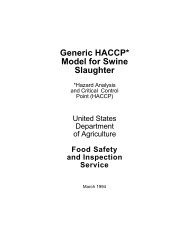Generic HACCP Model for Thermally Processed Commercial
Generic HACCP Model for Thermally Processed Commercial
Generic HACCP Model for Thermally Processed Commercial
You also want an ePaper? Increase the reach of your titles
YUMPU automatically turns print PDFs into web optimized ePapers that Google loves.
Physical and Chemical Contamination<br />
Andres, C. 1981. Food processors benefit from 2-piece vs. 3-piece can technology race. Food<br />
Processing 42(6):124-126.<br />
Advantages and drawbacks of 2- and 3-piece cans are discussed in the light of comments<br />
from can manufacturers and food processors. 2-piece cans eliminate side- and<br />
bottom-seams, thus reducing solder contact areas and lead (Pb) contamination, and<br />
improving can integrity. 3-piece cans with welded side seams also eliminate Pb<br />
contamination from this source, and are preferred <strong>for</strong> foods where both ends of the can<br />
are opened <strong>for</strong> serving. FDA figures are presented to show that levels of Pb in canned<br />
foods have declined since 1974, probably due to the advent of 2-piece cans and welded<br />
side seams.<br />
Barbieri, G. 1983. [Tinplate cans <strong>for</strong> foods, soldered with Lead/Tin (Pb/Sn) alloys.] Rivista della<br />
Societa Italiana di Scienza dell'Alimentazione 12(2):125-126.<br />
Uptake of Pb by foods in cans with longitudinal seams soldered with Pb/Sn alloys is<br />
discussed, with reference to: possible health hazards; Pb concn. in canned foods; increases<br />
in Pb concn. during storage; use of Pb-free Sn solder; quality control; and developments<br />
in can-making technology reducing the risk of Pb contamination (e.g. use of 2-piece<br />
cans).<br />
Biffoli, R., et al. 1980.[Contamination of canned foods with metals.] Rivista della Societa Italiana<br />
di Scienza dell'Alimentazione 9(4):241-246.<br />
A total of 98 samples of canned foods (including tomato, meat, tuna, vegetable and fruit<br />
products), collected from retail sources over the period Jan. 1978-July 1979, was<br />
analysed <strong>for</strong> iron (Fe), Sn and Pb by AAS. A table of results is given. 27 of the 98 cans<br />
were in poor condition. Overall ranges of values were (p.p.m.): Pb traces-10.1; Sn<br />
8.5-34.6; and Fe 2.8-1710. 37 samples had Pb concn. less than 1 p.p.m., 30 had Pb concn.<br />
of 1-2 p.p.m., 9 had Pb concn. of 2-3 p.p.m., and 22 had Pb concn. greater than 3 p.p.m.<br />
Similarly, 13 samples had Sn concn. less than 50 p.p.m., 35 had Sn concn. of 50-100<br />
p.p.m., 30 had Sn concn. of 100-200 p.p.m., and 20 had Pb concn. greater than 200<br />
p.p.m.; and 74 samples had Fe concn. less than 50 p.p.m., 6 had Fe concn. of 50-100<br />
p.p.m., 8 had Fe concn. of 100-200 p.p.m. and 10 had Fe concn. greater than 200 p.p.m.<br />
Data are also given <strong>for</strong> 2 cans of anchovies in sauce purchased in May 1974 and analysed<br />
with the other samples; at the time of examination, the cans were in poor condition.<br />
Concn. of metals in the can contents were (p.p.m.): Pb 14 and 45; Sn 740 and 1840; and<br />
Fe 1048 and 5800. The potential<br />
health hazard from canned foods with high Pb contents is discussed, with reference to<br />
72



